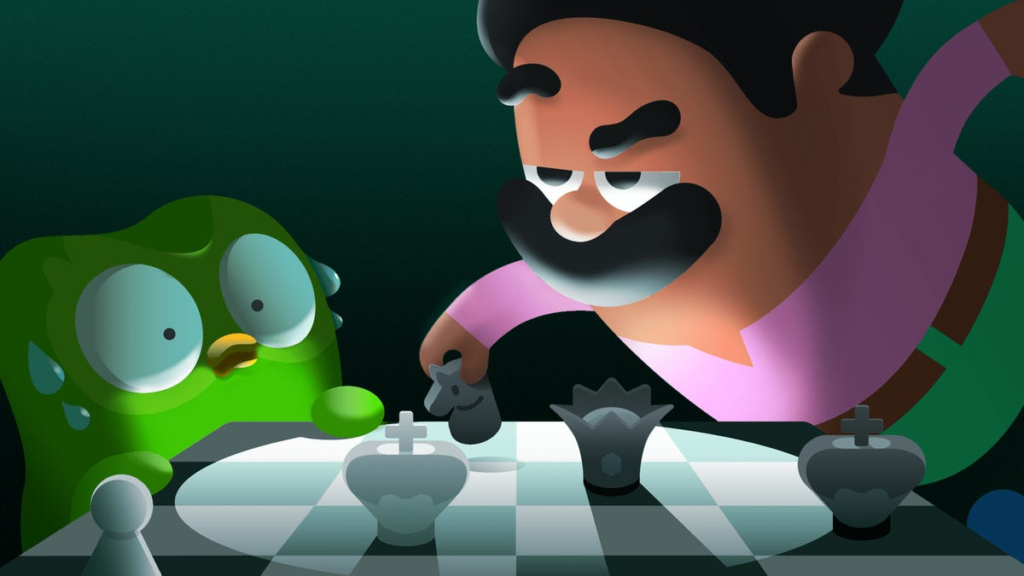“Hola, ajedrez,” means “Hello, chess” in Spanish. You’ve always been able to learn Spanish on Duolingo, and soon you’ll be able to learn and practice chess on the language learning app, too. Duolingo announced on Tuesday that beta testers can practice the centuries-old board game in Duolingo now, and others will be able to learn the game on the app in a few months.
Duolingo’s chess lessons aim to be beginner-friendly
I spoke with a Duolingo rep about the upcoming lessons. They said they wanted to continue expanding what people can learn through the app, and chess was an early contender.
“[Chess is] one of those things that … any age group can learn … but then also something that takes the 10,000-hour theory to really master,” Edwin Bodge, a senior product manager with Duolingo, said. “We thought it would fit with the Duolingo medium really well.”
When I asked why people would use Duolingo over other chess learning sites and tools, Bodge said a lot of other chess content is geared toward advanced users, not newcomers.
“We really saw a great opportunity to try and cater to more of a beginner, medium [player] and try and increase access to the game,” he said.
The chess lessons are slightly different from others you might find on Duolingo, like Spanish and math, but the progression system is similar. And from what Duolingo showed me, the lessons really do start at square one — or at a1 on a chessboard.
Chess lessons should feel similar to other Duolingo lessons
When you start, Duolingo asks how much you already know about chess — like in other lessons on the app. Duolingo will then adjust the lessons according to your response.
If you say you’re brand-new to chess and have no knowledge of the game, early lessons will focus on how each piece moves before moving on to capturing other pieces and checking the king. Other lessons are similar to mini-puzzles where you might be asked to capture different pieces using a single piece, like your knight or rook, in four moves or fewer.
You can access hints for each lesson, but if you get something wrong, your opponent will react to show you you’ve left a piece open for capture, like in a real match. And if you keep getting something incorrect, Duolingo will show you what to do.
“If you get it wrong multiple times, eventually we’ll show you an arrow that shows you exactly where to move,” Sammi Siegel, a software engineer with Duolingo, said.
If you are subscribed to Duolingo Max and make a mistake in a language lesson, the app can explain the mistake — and what the right solution is — with a feature called Explain My Answer. However, that feature won’t be available with the chess lessons for now. It’s not always easy to explain why something is right or wrong in chess because there are so many millions of different moves.
“We want to get better at fuller explanations,” Siegel said. “There is some mix of AI and model training that we’re hoping to use to better explain why a certain move is wrong.”
Because there are so many moves in chess, it’s possible to make moves that could be correct but aren’t the best options. In such instances, Duolingo will show a banner that lets you know that a move isn’t wrong but isn’t necessarily the best move.
Duolingo also said each section represents a range on the Elo rating system — the method by which a chess player’s skills are calculated. As you progress, your lessons will be tougher and more challenging. This is similar to the CEFR language proficiency levels attached to the different language sections in the app.
You’ll also have the opportunity to have “mini-matches” or full-on games against Duolingo’s chess coach, Oscar. These matches will scale in difficulty to challenge you as well, so you aren’t facing a grandmaster-level chess player after your first week of playing the game. But that doesn’t mean you can slack off and play sloppily. If you make a mistake, like leaving your queen open to capture, Oscar will take advantage and leave you scrambling to recover.
While playing against Oscar is good practice, you won’t be able to face off against other players when these chess lessons launch. But Duolingo said matches against other people are something they are looking into, so you might be able to play against a friend over the app in the future.
“One of the big reasons why we’re doing this is we think we can get a whole generation of people interested in chess,” Bodge said.
Duolingo’s chess lessons are in beta now and will begin rolling out on iOS in English around mid-May. Duolingo said it is working to bring these lessons to Android devices and more languages in the coming months.
For more on Duolingo, here’s how well the free version prepared me for a trip to Italy and our review of the language learning app. You can also check out our best language learning apps.
Read the full article here

